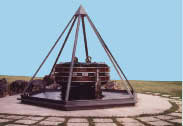|
|
|
|
Monday, 15 March 2004 - h. 15:00 Aula A1 PeV Cosmic Rays
- A Window on the Leptonic Era?
Abstract According to the Big Bang model, the Universe is filled with (anti-)neutrinos. When the Universe was about one second old, these particles decoupled. Since that moment, their wavelengths have been expanding in proportion to the size of the Universe. Their present spectrum is believed to be a momentum-redshifted relativistic Fermi–Dirac distribution, characterized by a temperature of 1.95 K. The present density of these Big Bang relics is estimated at ∼ 100 cm−3, for each neutrino flavor. That is nine orders of magnitude larger than the density of baryons in the Universe. In spite of this enormous density, relic neutrinos have until now escaped direct detection. The single most important reason for that is their extremely small kinetic energy, which makes it very difficult to find a process through which they might reveal themselves. The only indirect indication for their existence is the “missingmass” phenomenon, i.e. the apparent discrepancy between the gravitational mass and the luminous mass in our own and other galaxies. In this talk, I will propose a process through which relic neutrinos might be observed, and I will present experimental evidence for the occurrence of this process. I will show that a variety of characteristic features of the high-energy hadronic cosmic ray spectra, in particular the abrupt changes in the spectral index that occur around 3 PeV and 300 PeV, as well as the correspondingc hanges in elemental composition that are evident from kinks in the Xmax distribution, can be explained in great detail from interactions with relic Big Bang antineutrinos, provided that the latter have a mass of ∼ 0.5 eV/c2. |
